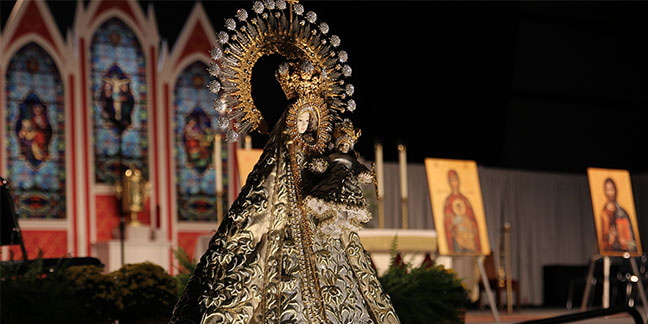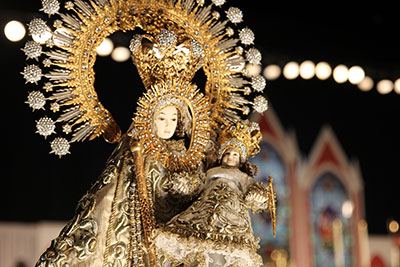 Our Lady of Manaoag is a title of the Blessed Virgin Mary venerated in Manaoag, a town in Pangasinan, the Philippines. Under this title, she is invoked as patroness of the sick, helpless and needy.
Our Lady of Manaoag is a title of the Blessed Virgin Mary venerated in Manaoag, a town in Pangasinan, the Philippines. Under this title, she is invoked as patroness of the sick, helpless and needy.
The devotion to Our Lady of Manaoag includes two feast days: the first in the summer, on the third Wednesday after Easter, and then again on the first Sunday in October. The summer feast commemorates the papal coronation of the image of Our Lady of Manaoag in 1926, and the October feast is connected to Mary’s title as Our Lady of the Rosary.
Our Lady of Manaoag is depicted in a 17th-century ivory and silver image of the Virgin Mary with the Child Jesus. Brought to the Philippines from Spain in the early 17th century by Father Juan de San Jacinto, the statue is now enshrined at the high altar of the Minor Basilica of Our Lady of the Most Holy Rosary of Manaoag.
The church was built on the site of a Marian apparition in Manaoag. Documents dating back to 1610 attest that a middle-aged farmer walking home heard a mysterious female voice. He looked around and saw on a cloud-veiled treetop an apparition of the Virgin Mary, holding a rosary in her right hand and the Child Jesus in her left arm, all amid a heavenly glow. Mary told the farmer where she wanted her church to be built, and a chapel was built on the hilltop site of the apparition, forming the nucleus of the present town.
Today, thousands of pilgrims flock to the shrine and basilica in Manaoag.
A replica of the statue is at St. Matthew Church in Charlotte, a gift from parishioner Joe Calicdan and his wife Cristy. Joe, who was born in Pangasinan, and his family have a deep devotion to Our Lady of Manaoag.
The statue features in the Eucharistic Procession for the annual Diocese of Charlotte Eucharistic Congress each year.
— Wikipedia, Catholic News Herald. Photos by SueAnn Howell, Catholic News Herald



 Pray the Novena to Our Lady of Manaoag:
Pray the Novena to Our Lady of Manaoag: